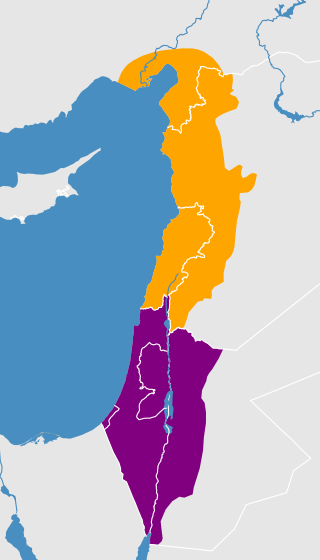This article has multiple issues. Please help improve it or discuss these issues on the talk page. (Learn how and when to remove these messages)
|
| Palestinian Arabic | |
|---|---|
| اللهجة الفلسطينية | |
| Native to | State of Palestine, Israel |
| Region | Palestine |
Native speakers | 4.3 million (2021)[1] |
| Dialects |
|
| Arabic alphabet | |
| Language codes | |
| ISO 639-3 | (covered by apc) |
| Glottolog | sout3123 |
| IETF | apc-PS |
 | |
Palestinian Arabic is a dialect continuum comprising various mutually intelligible varieties of Levantine Arabic spoken by Palestinians in Palestine, which includes the State of Palestine, Israel, and the Palestinian diaspora.[2][3]
The Arabic dialects spoken in the region of Palestine and Transjordan do not form a homogeneous linguistic unit; rather, they encompass a diverse range of dialects influenced by geographical, historical, and socioeconomic factors.[4] Comparative studies of Arabic dialects indicate that Palestinian Arabic is among the closest dialects to Modern Standard Arabic,[5] particularly the dialect spoken in the Gaza Strip.[6] Additional distinctions can be made within Palestinian Arabic, such as the dialects spoken in the northern West Bank and the Hebron area, which exhibit similarities to those spoken by descendants of Palestinian refugees.
Palestinian Arabic dialects reflect a historical layering of languages previously spoken in the region, including Canaanite, Hebrew (both Biblical and Mishnaic), Aramaic (especially Western Aramaic), Persian, Greek, and Latin. Furthermore, during the early modern period, these dialects were influenced by Turkish and various European languages. Since the establishment of Israel in 1948, Palestinian Arabic has also been shaped by Modern Hebrew influences.[7]
- ^ Palestinian Arabic at Ethnologue (26th ed., 2023)

- ^ "How to Reach your Audience with the Right Dialect of Arabic". Asian Absolute. 2016-01-19. Retrieved 2020-06-24.
- ^ "Arabic Language: Tracing its Roots, Development and Varied Dialects". Day Translations. 2015-10-16. Retrieved 2020-06-24.
- ^ Palva, H. (1984). "A general classification for the Arabic dialects spoken in Palestine and Transjordan". Studia Orientalia Electronica. 55: 357–376.
- ^ Kwaik, K.; Saad, M.; Chatzikyriakidis, S.; Dobnik, S. (2018). "A Lexical Distance Study of Arabic Dialects". Procedia Computer Science. The 4th International Conference on Arabic Computational Linguistics (ACLing). 143 (published 15 November 2018): 1, 3. doi:10.1016/j.procs.2018.10.456. ISSN 1877-0509.
- ^ Harrat, S.; Meftouh, K.; Abbas, M.; Jamoussi, S.; Saad, M.; Smaili, K. (2015). "Cross-Dialectal Arabic Processing". Computational Linguistics and Intelligent Text Processing. Gelbukh, Alexander (Ed.). Lecture Notes in Computer Science. Vol. 9041. Springer, Cham. (published April 14–20, 2015). pp. 3, 6. doi:10.1007/978-3-319-18111-0_47. ISBN 978-3-319-18110-3. S2CID 5978068. Retrieved 29 November 2022.
- ^ Bassal, Ibrahim (2012). "Hebrew and Aramaic Substrata in Spoken Palestinian Arabic". Mediterranean Language Review. 19: 85–104. ISSN 0724-7567. JSTOR 10.13173/medilangrevi.19.2012.0085.